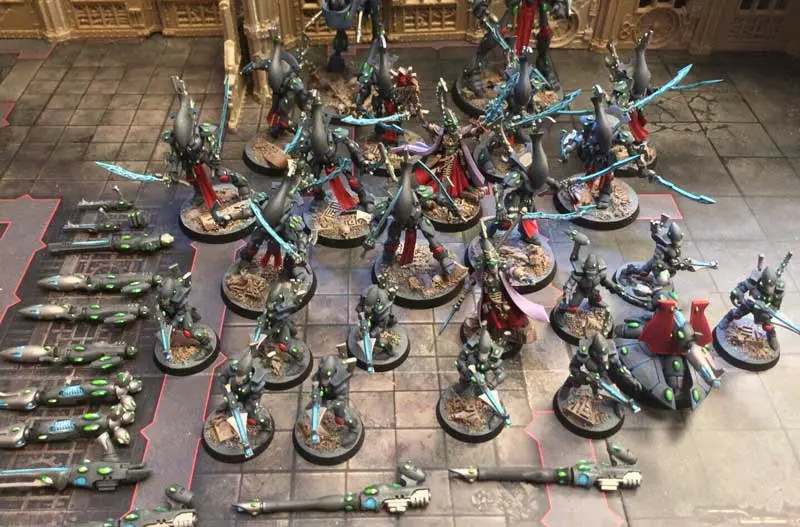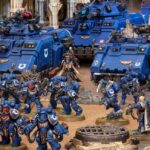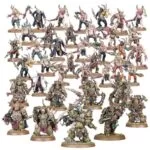How to build a Warhammer 40k army


The act of building a Warhammer 40k army is quite involved. Tactics, strategies, and limits are abundant. Knowing where to go with them can be troublesome to wrap your head around at times. Which is fine, that’s how we all start.
Key guidelines to army building can be tough to discern on your lonesome.
The plentiful rules, different unit options, and other concerns are enough to make some basic requirements fall by the wayside. Unfortunately, those are exactly the ones that help list-building the most.
Understanding the Basics: What You Need to Know to Start Building Your Army
Before building an army, let’s go over a few limits you’ll have to work with:
- Size dictates how many detachments you can bring and detachments dictate how many units you can bring from each subcategory.
- In the matched play, you can only bring 3 of the same unit, unless they are troops
- Each unit has its own restrictions written on its datasheet (squad size limit, available wargear, etc.)
Types of armies in Warhammer 40K
In Warhammer 40k, each faction can be put as its own playstyle, but there are some rough archetypes that they can be split into.
These would be:
- Range focused armies: Shooting armies that want to stay far away. Your gunline is difficult to rival and deal with.
- Melee focused armies: Armies that want to get in close quarters for maximum efficiency. Usually good at charging as well as fight phase.
- Swarm armies: Have a ton of weaker units, and can soak up shots with the sheer body count.
- Elite armies: Have fewer units of which each is extremely powerful.
- Psychic armies: Utilize psykers and their spells a lot.
- Fast armies: A lot of mobility on most units, can close the gap or reach objectives fast.
Choosing Your Warhammer Army: Which Faction is Right for You?
Everybody has their own style of play in Warhammer 40k. The factions of the game are more than capable of accommodating any of those.
Deciding on which to fetch is going to require some exploration of your own style.
Determine your preferred playstyle
While nobody knows off the cuff what their favored playstyle would be, it pays to ask yourself a few questions.
- Do you want to wait for the enemy or take the fight to them?
- Do you want a ton of units or a specialized couple of squads?
- What phase of the game do you generally prefer?
- What have you liked in armies you’ve encountered so far?
- Do you like using vehicles or infantry more?
- How do you generally play around with objectives?
Answer these and write them down. Then get to exploring the factions based on how closely they fit the criteria. An army may not perfectly answer to all of your likes but still strike your fancy, so pay attention to what’s out there.
Must-Have Units for Every Army
Building a successful Warhammer army requires careful consideration and planning. One of the key factors to consider is the selection of units that will make up your army.
While the exact makeup of an army will depend on your preferred playstyle, there are certain units that are essential for almost any army.
Understanding these essential units can help you build a powerful and effective army.
- Space Marines: Incursors
- Custodes: Custodian Guard (Storm Shields)
- Grey Knights: Paladins
- Sisters of Battle: Sisters Repentia
- Imperial Guard: Manticore
- Adeptus Mechanicus: Ironstrider Balistarii
- Imperial Knights: Knight Warden
- Orks: Warboss (Bike)
- Chaos Marines: Chaos Terminators
- Death Guard: Poxwalkers
- Thousand Sons: Ahriman
- Chaos Daemons: Exalted Lord of Change
- Eldar: Hornets
- Dark Eldar: Succubus
- Harlequins: Skyweavers
- Tyranids: Swarmlord
- Genestealer Cults: Acolyte Hybrids
- Necrons: Necron Warriors
- Tau: Riptide
Incorporating these must-have units into your army composition can provide a significant boost to your overall combat prowess. Careful consideration of these units during army building can give you an edge on the battlefield and help ensure victory in battle.
Don’t overlook the potential benefits of these powerful additions to your roster.
How to use the codex for building your army
Codex gives ample references to army rules and unit stats. This book will allow players to reference where certain abilities are applicable, which is key to firm army building.
While knowing every intricacy isn’t required, advancing your knowledge of unit synergies is sure to improve their power.
The army datasheets will help by providing direct information on available units. Additionally, the equipment section of those sheets should tell you the preferred role of a unit.
Stratagems found within will allow for some extra customization and sudden boosts of your army mid-battle. Certain factions have stratagems that give special rules for certain units.
These are considered special detachments that you can purchase with Command Points before the game starts. Other stratagems generally augment specific actions or phases, giving extra power temporarily.
Use your points wisely to build a competitive army
Points are a precious resource with which one can build an army. Depending on the size of the game, even a few points could be game-changers. Which is why it’s important to get the most bang for your buck.
Using army points correctly means gauging how much worth a unit is based on its stats. The usual worth goes up with special rules, exclusive wargear, or synergy with other units.
Additionally, diversifying your selection is quite important. There are some must-have units but they shouldn’t be the entirety of your army.
Remember that a more expensive unit isn’t necessarily better. There are cases where you can easily afford a more expensive unit but if that price won’t be put to good use, or is simply excessive, there’s no need to make changes.
Choosing units and models for your army
We noted diversifying, but how does one do it? It’s a process that generally changes from faction to faction, as each has different approaches to achieving that.
However, the general guidelines to diversify your army stay the same:
Choosing units and models should be done in a manner that will make your army capable of handling different threats while staying active in each phase of the game. Even if an army excels in a single phase, it’s bad practice to solely reinforce that one.
We can find a decent example in Tau, which mostly lacks melee capabilities. However, their infantry can still charge to tie up an enemy target that’s gotten too close and protect more important units from melee.
If the player has more points they could use cheap auxiliary units such as Kroots to tie up the enemy in combat. Kroots aren’t great at melee but are far better than Tau, meaning you’ll stay active during charge and fight phases while still keeping all of your shooting units safe.
A side investment of units that counter our army’s weakness allows for more tactical options. While the points should mostly be spent to reinforce the phase or playstyle you are strongest in sprinkling part of those into weaker aspects of the army making them a more omnipresent threat.
Choosing the right equipment for your army
Equipment can be even more important than the general stats of a unit. Certain models can change in functionality through wargear shift alone. That’s why paying attention to available weapons and gear is always important.
Reinforce the thing you’ll use the unit for with the wargear you give them. Give even better guns to your gunlines and unique melee weapons to the close quarters fighters.
For example, if you have a unit of Space Marine Intercessors and plan to use them as a long-range support unit, equipping them with Stalker Bolt Rifles instead of regular Bolt Rifles will increase their effectiveness against vehicles and characters.
Alternatively, if you have a unit of Ork Boyz that will be charging into close combat, giving them Choppas instead of Sluggas will make them deadlier in melee.
Strategies for Success: How to Build a Competitive Army
Having something for every range is the key part of army building. A good army covers long, mid, and short ranges efficiently no matter where their strength lies.
Consider units that can go off on their own, causing trouble for the opponent without any support. These are often deep strike units, ones that can deploy anywhere as long as they are a certain distance from the enemy but only on turns past first, which can quickly interrupt gunlines or artillery.
Units needn’t shoot to be viable at long range but they need to be capable of entering the range at which they pose a threat from long range. The same goes for any other range, it’s about them posing a threat from that distance rather than being exclusively tied to the range of their guns.
Big guns and small guns both serve a purpose. Have both on hand when making an army, your heavy hitters will help crush resistant troops or vehicles in a few shots. The smaller arms are there to pepper regular infantry, taking out models without overkill.
Do not ignore special rules that may be purchasable for the army. Certain ones can make a difference between a powerful unit and a mediocre one.
Points, Units, and Formations
Points in a game of Warhammer 40k carry weight even outside of building an army. Each kill or loss is calculated through points, making certain actions harm the opponent more.
A unit represents all models inside a squad. A unit counts as such even if it ends up having a single model left.
Formations come back to 9th edition in the form of Armies of Renown. This is a mechanic that requires your army to conform to certain restrictions. If they do, you get some powerful special rules for all appropriate units.
These three are important things to note as we proceed with some key guidelines. As well as things to keep in mind when army-building.
Playing to Your Army’s Strengths: Tactics and Deployment
Composing a list should give you some insight into how a faction can excel. Special rules, wargear, and stats will quickly clue you in on this.
Once you’ve learned the faction’s options, it’s all about maximizing the utility of the army’s strengths. This extends to phase-by-phase tactics as well as deployment.
Tactics
General tactics you can utilize with any army involve the following:
- Getting into cover
- Securing objectives and reinforcing position
- Flanking enemies
- Screening (using weak enemies to protect stronger ones from enemy abilities/charges)
- Eliminating characters when possible
Deployment
Good deployment is all about keeping your opponent guessing until the game starts. For good deployment, put down general-use infantry that will cap objectives first.
Then, place the units that go centrally. These two form an important pressure tool but are generally not the primary playmakers of your army.
Third, deploy your key strategy. This will be your army’s biggest hitters. Whether it’s a fully kitted out vehicle or a devastating squad of elites, put them down third.
Lastly, we have the deployment of our counter units. These will be specialized models that take care of a specific type of danger (eg. antitank or assassin units). By deploying them last, we can better position them so their desired target is within range during the first turn.
Common Mistakes to Avoid When Building Your 40k Army
Making mistakes is expected when so many moving parts are present. Some mistakes are more common than others and can be hard to dispel because they just come naturally to people.
Here are the ones to look out for when building your Warhammer army.
Taking a bit of everything
While diversifying a list is important, taking too many varied options in your army can make it feel watered down in purpose. Reinforce all ranges but always have a solid game plan and purpose for the units you pick.
Ignoring Wargear
Oftentimes, new players will just take the default weaponry without checking what alternative loadouts they can get.
This is generally fine but can often obscure the versatility of a unit choice. Especially for troops that get different weapon options or extra rules.
Sticking to a rigid gameplan
It’s easy for a player to get distracted from covering weaknesses and focusing squarely on strengths. That’s understandable as being effective is key for each unit in the army.
However, a lack of flexibility makes your army more susceptible to breaking the second the initial strategy is broken.
Print and save: guidelines for building a Warhammer 40k army
- Diversify unit choices
- Enhance strengths with upgrades
- Don’t overcommit to a strat
- Make an army draft before finalizing selection
- Use wargear
- Cover all ranges of the game
- Cover as many phases of the game
Conclusion
Building a Warhammer 40k army is all about maximizing diversity and power. The balancing act isn’t something you’ll get right the first time around but the more you play the more apparent it becomes.
Some really meta armies don’t conform to certain guidelines given here but keep in mind that those play in an entirely different format to 99% of Warhammer 40k games.
I recommend playing and enjoying the game at a base level before attempting to follow meta armies, if at all.





